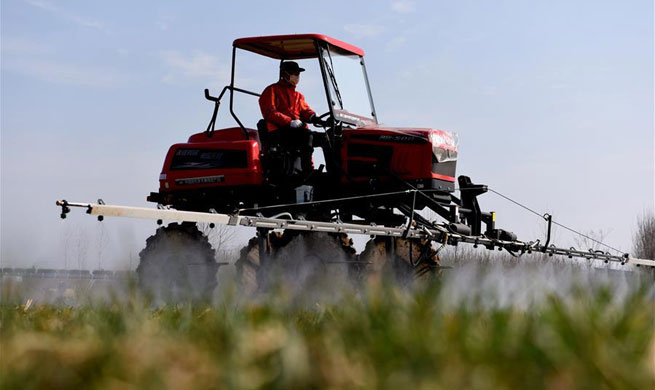NAIROBI, Feb. 12 (Xinhua) -- When a swarm of desert locusts invaded Mandera in northern Kenya from neighboring Somalia early January, many farmers in the heartlands thought the ravenous insects would be contained there.
However, despite the national and county governments stepping up efforts to eliminate them through aerial spraying, the voracious insects have been spreading in different parts of Kenya, leaving a trail of destruction.
The insects are raising food security fears as farmers in areas where the locusts have invaded count losses.
In Embu, central Kenya, many farmers have lost their crops planted during the October to December 2019 rain season, which recorded enhanced rainfall to the benefit of producers.
Beatrice Ngari, a farmer in the area is among those who lost their crops to the insects. She had planted cowpeas, beans and green grams capitalizing on the extended rains.
"The crops had done well because of the heavy rains and I was looking forward to a bumper harvest but then the locusts came and ate away my hope," she recounted recently.
In their thousands, the locusts descended on her farm and the neighboring ones and by the time residents were beating metal cooking pots and making noise to scare them away, the destruction was already done.
The county government stepped in and soon started aerial spraying of the locusts but the measure came a little late, with farmers like Ngari losing their investment.
"I had spent 105,000 shillings (some 1,050 U.S. dollars) on my farm to grow the crops hoping to make at twice that amount but that is now all gone," said Ngari.
In the neighboring Tharaka Nithi, a semi-arid region, the locusts have destroyed thousands of acres of millet and sorghum leaving farmers devastated.
Residents in the dry region rely on the crops for livelihood, selling the sorghum in particular, to beer makers in Nairobi.
Heavy rains in last year's October-December season had seen farmers extend acreage under the crop to reap more.
"All our investment is going down the drain. The sorghum and millet crops were about to mature and we would have harvested next month but that now remains a dream," said Nathan Njiru, a farmer.
From northern Kenya, the locusts spread to eastern Kenya before reaching central Kenya and the latest county to record the locust invasion is Kajiado, located in the Rift Valley and south of the capital Nairobi.
"The swarm of locusts that have roosted in the area is the same destructive breed that was first reported in Mandera. They are in full incubation period and are feeding on all vegetation," said Kajiado Governor Joseph ole Lenku on Monday.
The governor said the county had procured motorized and knapsack sprayers and hundreds of liters of pesticides to spray the insects as they wait for aerial spraying.
Farmers in the vast dry region inhabited by pastoralists has in recent years recorded a surge in irrigation agriculture, with the food sold in the capital where there is a ready market. They have expressed fear that the voracious insects may wipe out their investment.
"I have five acres under traditional vegetables, onions and tomatoes and if the locusts are not contained in time, then we may lose our crop," said Bernard Ngunjiri, noting the locusts are not also sparing pasture.
The Food and Agriculture Organization of the United Nations (FAO) warned on Jan. 29 that the desert locusts present an extremely alarming and unprecedented threat to food security and livelihoods in the Horn of Africa.
Keith Cressman, senior locust forecasting officer at FAO, said the outbreak is the worst in decades and is being worsened by new breeding in Kenya, Ethiopia and Somalia, with the insects spreading to Uganda and Tanzania.
Agriculture specialists noted that the desert locusts pile pressure on Kenyan farmers who have been ravaged by climate variability effects in the last years.
"If it is not a lengthy dry spell or extended period of rains that destroy crops, Kenyan farmers are battling diseases like maize necrosis and pests like fall armyworm,"said Beatrice Macharia of Growth Point, an agro-consultancy.
The locusts menace is the latest threat to food production in Kenya and all this is due to climate change because the weather conditions are perfect for the breeding of such pests," Macharia.













